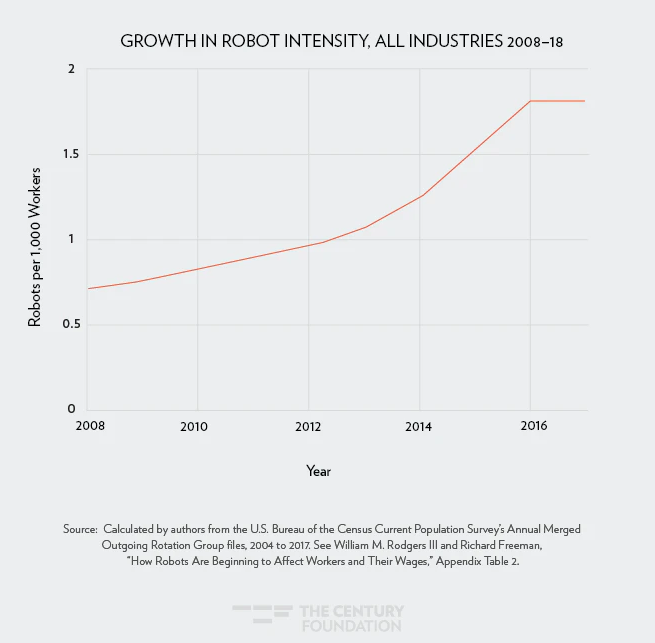These US states are most at risk of losing jobs to automation

Image: REUTERS/Aly Song
- A new report maps the top 10 areas of the US with the highest robot intensity
- In the last decade, the number of manufacturing robots has more than doubled in the US to almost 2 per 1,000 workers
- Some studies predict as many as 50% of all workers are at risk of losing their jobs to automation
Robots are displacing younger, less-educated, and minority workers in the Midwest manufacturing industry at the highest rates, a new report shows.
However, the findings also show that a strong economic recovery over the past decade has saved many jobs and slowed automation in the United States.
The report shows that robots have not yet brought the dire nationwide effects that many have warned about, but the impact of robots varies across groups of workers, regions, and industries.
Estimates of the potential impacts of robots on the US economy vary widely, with some studies predicting that as many as 50% of all workers are at risk of losing their jobs to automation in the coming decades.
The report examines what is happening in practice, estimating the impact of rising automation in the wake of the Great Recession, from 2009 to 2017, a period in which the use of industrial robots in the United States has more than doubled. The Great Recession was the economic downturn from 2007 to 2009 after the US housing collapse and global financial crisis.
Where are robots replacing workers now?
“There have been clear losers with increased automation—namely, younger, less-educated manufacturing workers in the Midwest and younger, minority workers in these industries in particular,” says coauthor William Rodgers, a professor of public policy at Edward J. Bloustein School of Planning and Public Policy and chief economist at the Heldrich Center for Workforce Development at Rutgers University.
“These industries not only have the highest number of robots in use, but are also experiencing the fastest growth in robot adoption.”
Rodgers says the economic recovery of the past decade has masked some of the adverse impacts on the wages and jobs of Midwest manufacturing workers. Absent such a strong recovery, robots would have displaced many more jobs than they did.
The report found that the top 10 areas with the most robot intensity are:
1) Los Angeles-Long Beach-Santa Ana, California;
2) Chicago-Naperville-Joliet, Illinois;
3) Houston-Baytown-Sugar Land, Texas;
4) Phoenix-Mesa-Scottsdale, Arizona;
5) Detroit-Warren-Dearborn, Michigan;
6) Milwaukee-Waukesha-West Allis, Wisconsin;
7) Philadelphia-Camden-Wilmington, Pennsylvania-New Jersey-Delaware-Maryland;
8) San Jose-Sunnyvale-Santa Clara, California;
9) Indianapolis, Indiana;
10) Cleveland-Elyria, Ohio.
The researchers mapped out the robot intensity in the 262 most affected metropolitan areas in the US.
Other key findings
- During the Great Recession, robot intensity—the use of robots—plummeted. But since 2009, robot intensity has sharply increased nationwide.
- States in the Midwest (the East North Central, or ENC, census division) consistently have the highest robot intensities, typically at least twice the intensity of all other regions.
- Since 2009, the number of manufacturing robots has more than doubled—from 0.813 per 1,000 workers to 1.974 per 1,000 workers.
- The adoption of robots since the Great Recession has been accompanied by employment gains for some groups of workers, including young, less-educated men and less-educated adult women, and appears not to have affected other groups.
- In Midwest manufacturing industries, robots have sizably decreased wages for young, less-educated men, and women.
The findings suggest that at the current stage and pace of robot growth and with the right economic conditions in place, some workers without a college degree may benefit from robotization.
Rodgers says the experiences of young Midwestern minority and women workers, as well as employers and their communities, can help other parts of the country prepare for and minimize the economic, social, and cultural adjustment costs associated with the introduction and diffusion of robots.
Richard Freeman, a researcher at Harvard University, was the coauthor of the report. The full report is available here, published by the Century Foundation.
Don't miss any update on this topic
Create a free account and access your personalized content collection with our latest publications and analyses.
License and Republishing
World Economic Forum articles may be republished in accordance with the Creative Commons Attribution-NonCommercial-NoDerivatives 4.0 International Public License, and in accordance with our Terms of Use.
The views expressed in this article are those of the author alone and not the World Economic Forum.
Stay up to date:
United States
The Agenda Weekly
A weekly update of the most important issues driving the global agenda
You can unsubscribe at any time using the link in our emails. For more details, review our privacy policy.









